CLANG!!! Once again I heard the same crisp, satisfying, precise, and metallic sound of the pin tumbler lock giving me a brief but powerful confirmation of access granted.
I, Emma Marshal, opened the door with a satisfying click, recalling the day I first met Mr. Arthur, a master of pin tumbler locks.
His expertise and passion sparked my curiosity, leading me down the path of locksmithing and uncovering the hidden wonders of this intricate craft.
I, now a skilled locksmith, fondly remembered the day I met Mr. Arthur. His expertise and passion for pin tumbler locks inspired me. I sought his help when I accidentally locked myself out, and Arthur, with his gentle guidance, skillfully unlocked the door.
I embarked on a journey to become a locksmith, learning from Mr. Arthur and other specialized institutes; unraveling the secrets of locks, and embracing a newfound passion for the craft.
Today I am here to share my knowledge of the intricacies of pin tumbler locks, exploring how does a pin tumbler lock work, its vulnerabilities, its purpose, and the techniques used to pick a pin tumbler lock. So what are we waiting for…Let’s get started.
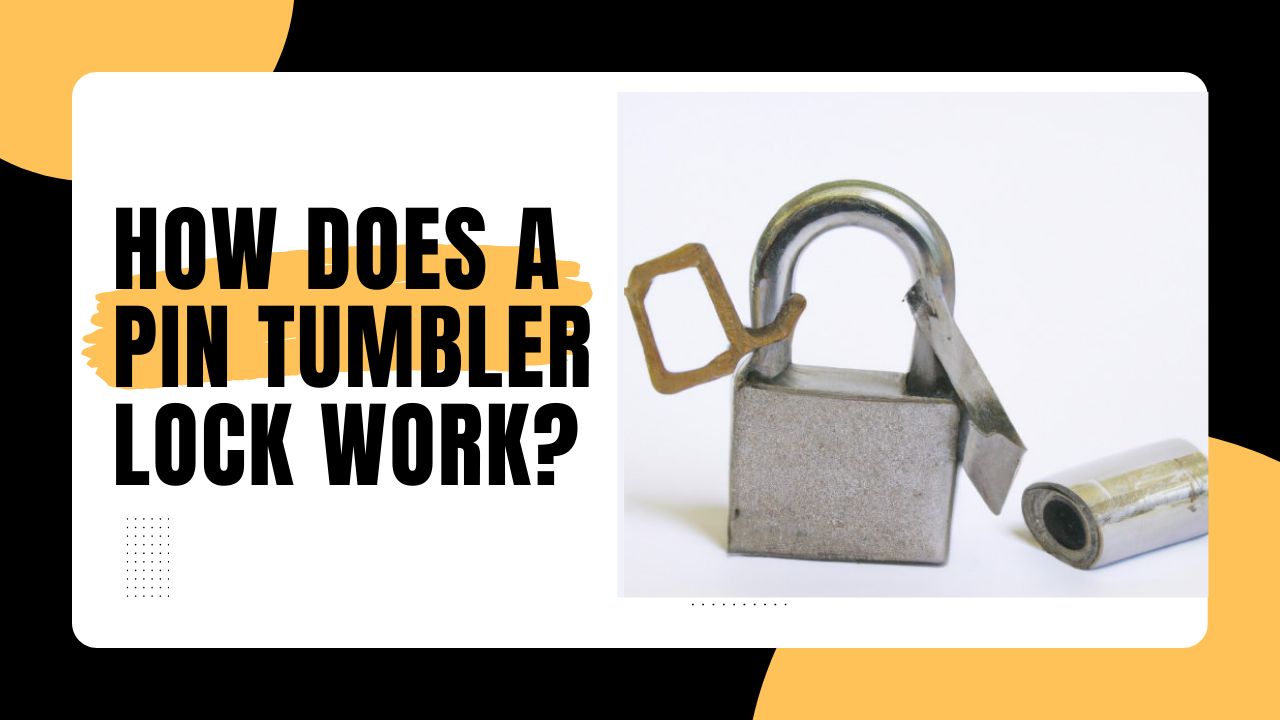
Contents
- 1 What Is a Pin Tumbler Lock?
- 2 Pin Tumbler Lock History
- 3 Parts of a Pin Tumbler Lock
- 4 How Does a Pin Tumbler Lock Work?
- 5 Types of Pin Tumbler Lock
- 6 What Are Pin Tumbler Locks Used For?
- 7 How to Pick a Pin Tumbler Lock
- 8 Pin Tumbler Lock Vulnerabilities
- 9 Enhancing Pin Tumbler Lock Security
- 10 Conclusion
- 11 FAQ’s
- 12 Resources
What Is a Pin Tumbler Lock?
A pin tumbler lock is a common type of lock mechanism that relies on a series of pins to secure and release a lock. It is widely used in various applications, such as doors, cabinets, safes, and padlocks.
Pin Tumbler Lock consists of a cylindrical plug that rotates within a housing, and the plug has a narrow slot called a keyway for inserting the key.
The lock has pins of different lengths, with each pin having a top pin (driver pin) and a bottom pin (key pin).
When the correct key is inserted and turned, the pins align at the shear line, allowing the plug to rotate and unlock the Pin Tumbler Lock.
Pin Tumbler Lock History
The history of the pin tumbler lock dates back thousands of years, with the concept of using pins to secure mechanisms dating back to ancient Egypt and Rome.
However, it wasn’t until the modern era that the pin tumbler lock, as we know it today, was developed.
This ingenious lock mechanism revolutionized security systems and continues to be widely used worldwide.
Who Invented the Pin Tumbler Lock
Pin tumbler lock inventor Linus Yale Sr., an American locksmith, is credited with the invention of the modern pin tumbler lock.

In 1848, Yale developed a significant improvement to existing lock mechanisms, introducing the concept of using a flat key with serrated edges to align pins and allow for smooth rotation.
This innovative design greatly enhanced the security and efficiency of locks, making them more resistant to picking and tampering. Yale’s invention laid the foundation for the widespread adoption of pin tumbler locks in various applications, and his name became synonymous with quality and reliability in the locksmith industry.
Today, pin tumbler locks are still based on Yale’s original design principles and continue to safeguard our belongings and provide peace of mind.
Oldest Pin Tumbler Lock
The oldest known pin tumbler lock dates back to ancient Egypt and is known as the “Egyptian lock.”
Discovered in the ruins of the Palace of Khorsabad, near Nineveh in present-day Iraq, this remarkable lock is estimated to be around 4,000 years old.
The Egyptian lock features a wooden housing and a bronze key with pins and wards that align to unlock it.
This early pin tumbler lock demonstrates the ingenuity and craftsmanship of ancient civilizations in creating secure mechanisms.
Parts of a Pin Tumbler Lock
Pin tumbler locks consist of several essential components, including a lock cylinder, a plug, driver pins, key pins, and springs. Understanding the role of each component is crucial in comprehending how these locks operate.
1. The Lock Cylinder

The lock cylinder serves as the main housing for the lock components and is the part that is inserted into the door or other entryway. It contains chambers that accommodate the driver pins, key pins, and springs.
2. The Plug
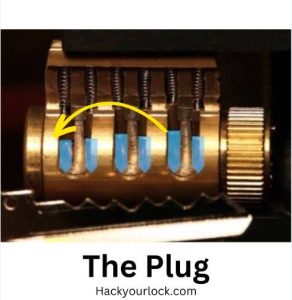
The plug is the rotating component of the lock cylinder. When the correct key is inserted and turned, it engages with the plug, allowing it to rotate and unlock the lock.
3. Driver Pins
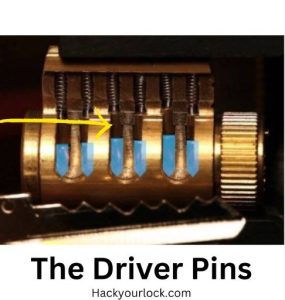
Driver pins are small, cylindrical components that rest between the plug and the key pins. Their purpose is to prevent the plug from rotating unless the correct key is inserted. The height of the driver pins determines the required key’s unique combination.
4. Key Pins

Key pins are responsible for aligning with the cuts and valleys of the key. When the correct key is inserted, the key pins align flush with the shear line, allowing the plug to rotate freely.
5. Springs

Springs provide tension within the lock cylinder, pushing the driver pins downward and applying pressure to the plug. This tension is what keeps the lock securely in place until the correct key is inserted.
6. The Shear Line
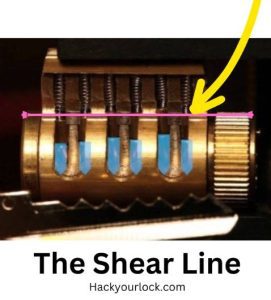
The shear line refers to a specific point or line within a lock mechanism where the inner and outer components align to allow the lock to open.
When the pins or tumblers within the lock are correctly aligned with the shear line, the key can smoothly turn and operate the lock.
If the pins are not properly aligned, the key will encounter resistance and the lock will remain locked.
7. Warding
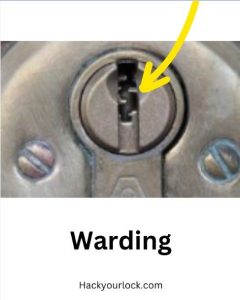
Warding refers to the strategic placement of obstacles or barriers within a lock mechanism to prevent the insertion of incorrect keys or unauthorized tools.
These obstacles, known as wards, are typically positioned in a way that only a properly shaped key can bypass them and align the lock’s internal components correctly.
Wards are designed to enhance the security of the lock by limiting access to only those keys specifically designed for that lock.
8. Pin Chambers
Pin chambers, also known as pin chambers or pin stacks, are components within a lock cylinder that contain pins or tumblers.

These chambers are designed to hold a series of pins of varying lengths or sizes. When a correct key is inserted into the lock, the pins within the pin chambers align along the shear line, allowing the cylinder to rotate and the lock to be opened.
The number and arrangement of pin chambers within a lock depend on the lock’s design and level of security.
9. The Key

A key is a small, usually metallic, device that is specifically shaped to operate a lock.
It is designed to be as compact as possible, with its size tailored to fit comfortably in a pocket or a keychain.
The key’s purpose is to align the pins or tumblers within a lock cylinder, allowing it to be turned and unlocking the corresponding mechanism.
By keeping the key size minimal, it enhances portability and convenience for the user while maintaining its functionality in operating the lock.
This was about pin tumbler lock, but if you want to know All About Locks then this is the place to go.
How Does a Pin Tumbler Lock Work?
Understanding “what is pin tumbler lock mechanism” has its importance because it helps in figuring out ‘how does a pin tumbler lock work’ and to gain insight into their vulnerabilities as well as the techniques used to manipulate them.
Let’s explore the process of locking and unlocking a pin tumbler lock:
1. Locking Process
When the lock is in the locked position and no key is inserted, the driver pins rest in the plug’s chamber, creating a gap known as the shear line.
The driver pins are pushed down by the springs, preventing the plug from rotating.
2. Unlocking Process
When the correct key is inserted into the lock, the key pins align with the key’s cuts and valleys.
This alignment causes the key pins to align perfectly with the shear line, creating a seamless transition between the plug and the lock cylinder.
As a result, the plug can rotate freely, unlocking the lock.
Types of Pin Tumbler Lock
Pin tumbler locks, a popular type of cylinder locks, come in various forms, each offering different levels of security. Here are some common pin tumbler locks:
1. Standard Pin Tumbler Locks
These are the most basic and widely used pin tumbler locks. They consist of a series of pin chambers and use pins of varying lengths.
The lock is secured when the driver pins align along the shear line, blocking the plug from rotating.
2. Master Key Systems
Master key pin tumbler locks allow for multiple keys to operate the same lock while also having individual keys that work on specific locks.
They are commonly used in buildings with various access levels, providing convenience and control.
3. High-Security Pin Tumbler Locks
These locks employ advanced features to enhance security. They may include additional security pins, specialized keyways, or complex designs that make manipulation or picking more difficult.
High-security locks are often used in commercial and high-risk environments.
4. Key Control Pin Tumbler Locks
Key control locks restrict unauthorized key duplication. They incorporate patented keyways or restricted key systems, requiring proper authorization to duplicate keys.
This helps prevent unauthorized access by controlling key distribution.
5. Tubular Pin Tumbler Locks
Tubular locks are cylindrical in shape and use pins that align along a circular shear line.
They are commonly found in vending machines, gaming machines, and certain types of furniture.
What Are Pin Tumbler Locks Used For?
The uses of pin tumbler lock define the purpose of pin tumbler locks. Pin tumbler locks are widely used for securing a variety of applications and premises.
Here are some common uses of pin tumbler locks:
1. Residential Locks:
Pin tumbler locks are commonly used in residential properties, including homes, apartments, and condominiums.

They provide a basic level of security for exterior doors, interior doors, cabinets, and other storage areas.
2. Commercial Buildings:
Pin tumbler locks are extensively employed in commercial buildings such as offices, retail stores, warehouses, and industrial facilities.
They secure entrances, offices, storage areas, and other important spaces within the premises.
3. Padlocks:
Pin tumbler locks are popular for securing gates, fences, lockers, storage units, bicycles, and other portable items.

They offer convenience, versatility, and moderate security.
4. Automobiles
Many vehicle ignition systems and door locks incorporate pin tumbler mechanisms.
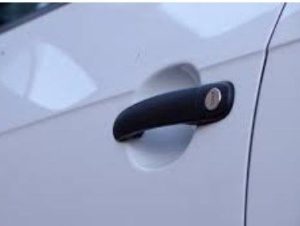
They ensure the security of cars, trucks, motorcycles, and other motor vehicles.
5. Safes, Lockboxes, and Furniture
Pin tumbler locks are often utilized in safes, vaults, and lockboxes to protect valuable assets, documents, and personal belongings.
They provide an additional layer of security to prevent unauthorized access.

Pin tumbler locks are employed in various furniture pieces, including desks, cabinets, drawers, and file cabinets.
How to Pick a Pin Tumbler Lock
Picking a pin tumbler lock involves manipulating the lock’s pins to align along the shear line without the use of a key.
This is typically done using specialized tools, such as lock picks or tension wrenches, to individually lift and set each pin to the correct position.
By applying tension to the lock cylinder and carefully manipulating the pins, a skilled locksmith or lockpicker can overcome the lock’s mechanisms and rotate the plug, unlocking the lock.
Check out How to Pick a Lock for Beginners: The Tech and Tools of the Trade for further details
Pin Tumbler Lock Vulnerabilities
While pin tumbler locks are widely used due to their effectiveness, they are not immune to vulnerabilities. Let’s explore some common weaknesses.
1. Picking
Picking involves manipulating the pins within the lock to align them correctly without using the original key.
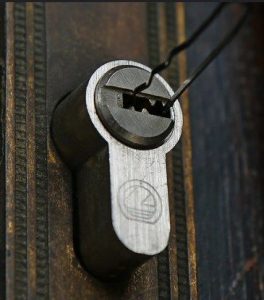
Skilled individuals can use various tools, such as picks and tension wrenches, to mimic the key’s function and achieve pin alignment.
2. Bumping
Bumping is a technique that utilizes specially crafted keys called bump keys.
These keys exploit the spring-loaded nature of pin tumbler locks to bump the driver pins, causing them to momentarily separate from the shear line and enabling the plug to rotate freely.
3. Brute Force Attacks
In extreme cases, pin tumbler locks can be compromised through brute force attacks.
These attacks involve applying excessive force to the lock, attempting to bypass the pin alignment mechanism.

However, modern pin tumbler locks are designed to resist such attacks.
4. Key Duplication
Unauthorized key duplication poses a threat to the security of pin tumbler locks.
If an unauthorized individual gains access to a key and duplicates it, they can potentially unlock the corresponding lock without raising suspicion.
5. Lock Pick Guns
Lock pick guns, also known as snap guns or bump keys, are tools designed to exploit the weaknesses in pin tumbler locks.
Here’s how they can be a vulnerability:
a. Speed and Ease of Use
Lock pick guns allow for rapid and relatively simple manipulation of pin tumbler locks. This speed can make them attractive to individuals attempting unauthorized access.
b. Minimal Skill Requirement
Individuals with limited training can potentially use lock pick guns to bypass pin tumbler locks because it generally requires less skill compared to traditional lock picking methods.
6. Comb Picks
Comb picks, also known as pick sets or rake picks, are tools with multiple “teeth” or “fingers” designed to manipulate multiple pins simultaneously.
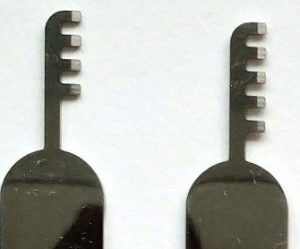
Here’s how they can pose vulnerabilities:
a. Simultaneous Pin Manipulation
Comb picks allow for the simultaneous raking or jiggling of multiple pins within the lock. This can result in a faster unlocking process compared to individually picking each pin.
b. Reduced Precision
Comb picks prioritize speed over precision, meaning they may not guarantee full control over individual pin positioning. This can lead to a higher chance of accidental unlocking or reliance on luck, rather than skill.
Enhancing Pin Tumbler Lock Security
To mitigate the vulnerabilities mentioned above and enhance the security of pin tumbler locks, various measures can be taken:
a) High-Security Locks
Opting for high-security pin tumbler locks with additional features can significantly improve resistance to picking, bumping, and other forms of attack. These locks often incorporate advanced design elements and materials, making them more challenging to manipulate.
b) Master Key Systems
Master key systems allow for multiple locks to be operated by a single key while still providing individual key access to each lock. Implementing a master key system adds convenience and control while maintaining security.
c) Restricted Keyways
Restricted keyways limit unauthorized key duplication by using specialized key blanks that are only available to authorized individuals or locksmiths. This reduces the risk of someone obtaining a key without proper authorization.
d) Regular Maintenance and Inspection
Regularly maintaining and inspecting pin tumbler locks is crucial to identify and address potential vulnerabilities or signs of wear. Lubrication, adjusting loose components, and replacing worn-out parts are essential steps in maintaining a lock’s integrity.
Conclusion
Pin tumbler locks remain one of the most widely used lock mechanisms due to their effectiveness and reliability.
Understanding how these locks function, their vulnerabilities, and the measures to enhance their security is vital for both locksmiths and individuals seeking to protect their property.
By implementing advanced security measures, such as high-security locks, master key systems, restricted keyways, and regular maintenance, we can ensure the continued effectiveness and resilience of pin tumbler locks in safeguarding our valuables and maintaining our peace of mind.
FAQ’s
Can pin tumbler locks be easily picked?
Pin tumbler locks can be vulnerable to picking, but skilled picking techniques require expertise and specialized tools. Choosing high-quality locks and taking additional security measures can significantly reduce the risk.
Can pin tumbler locks be rekeyed?
Yes, pin tumbler locks can be rekeyed, allowing for changes in key access. Rekeying involves replacing the existing key pins within the lock to match a new set of keys while preserving the existing lock mechanism.
Resources
- HOW TO PICK A LOCK S.T.E.M. Kit
- Research on Pin Tumbler Locks and the Characteristics of Surface Traces Formed by Unlocking Guns By Gao Yi 1 Jin Yifeng 2, * Bai Yanping 2, * Mei Hongcheng 2 Xu Zhen 2
- Train Your Brain – Learn How to Pick Locks by Chris Dangerfield
- Train Your Brain – Learn How to Pick Locks by DAVID NIELD
- How to Pick a Lock for Beginners: The Tech and Tools of the Trade
- All About Locks
